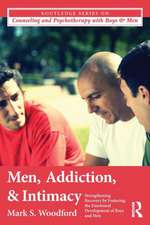Fertility and Sterility: The Proceedings of the XIth World Congress on Fertility and Sterility, Dublin, June 1983, held under the Auspices of the International Federation of Fertility Societies
Editat de R.F. Harrison, J. Bonnar, W. Thompsonen Limba Engleză Paperback – 10 iul 2012
Preț: 740.79 lei
Preț vechi: 779.77 lei
-5% Nou
Puncte Express: 1111
Preț estimativ în valută:
141.75€ • 148.39$ • 117.29£
141.75€ • 148.39$ • 117.29£
Carte tipărită la comandă
Livrare economică 07-21 aprilie
Preluare comenzi: 021 569.72.76
Specificații
ISBN-13: 9789401513104
ISBN-10: 9401513104
Pagini: 756
Ilustrații: XXVI, 726 p. 123 illus.
Dimensiuni: 155 x 235 x 40 mm
Greutate: 1.04 kg
Ediția:1984
Editura: SPRINGER NETHERLANDS
Colecția Springer
Locul publicării:Dordrecht, Netherlands
ISBN-10: 9401513104
Pagini: 756
Ilustrații: XXVI, 726 p. 123 illus.
Dimensiuni: 155 x 235 x 40 mm
Greutate: 1.04 kg
Ediția:1984
Editura: SPRINGER NETHERLANDS
Colecția Springer
Locul publicării:Dordrecht, Netherlands
Public țintă
ResearchCuprins
Inaugural address: trends and prospects for research on fertility and sterility in the 1980s.- I: Main Themes of the Congress.- Section 1: Neuro-endocrinology — Reproductive Releasing Hormones.- 1 Mechanisms regulating LHRH release: implications for fertility regulation.- 2 Medical castration in men: the first clinical application of LHRH agonists.- 3 Reproductive releasing hormones — the future.- Section 2: Prediction and Detection of Ovulation.- 4 The physiological basis of the fertile period.- 5 Biochemical methods for predicting ovulation.- 6 Ultrasound and follicular development.- 7 Methods of identifying the fertile period.- 8 A critical review of natural family planning studies.- Section 3: Fertilization in vitro and in vivo.- 9 Current status of human in vitro fertilization.- 10 Events leading to fertilization in mammals.- 11 Early human embryology.- 12 Organization of an in vitro fertilization programme.- 13 Clinical experiences with in vitro fertilization and embryo transfer programmes.- Section 4: Tubal Factors in Reproduction.- 14 Physiology of tubal function.- 15 The epidemiology of salpingitis.- 16 Pelviscopic therapy for tubal disease.- 17 Prevention of postoperative adhesions.- Section 5: Immunology and Reproduction.- 18 Immunological aspects of implantation.- 19 The nature of the placental immunological barrier.- 20 Detection of immunoreactive materials in body fluids.- 21 Immunological methods of birth control.- 22 Treatment of immunologically conditioned infertility.- Section 6: Male Fertility.- 23 Epididymal function.- 24 Gossypol.- Section 7: New Approaches to Female Fertility Regulation.- 25 New approaches to female fertility regulation — an overview.- 26 Recent progress in the use of copper IUDs.- 27 Steroid-releasing vaginal rings: areview.- 28 Postcoital contraception: experiences with ethinyloestradiol/norgestrel and levonorgestrel only.- Section 8: Lactation and Birth Spacing.- 29 Lactation and birth spacing: an overview.- 30 Clinical, hormonal and ultrasonic indicators of returning fertility after childbirth.- 31 Steroidal contraception and lactation.- 32 Birth intervals — demographic factors.- Section 9: Psychosocial Aspects of Reproduction.- 33 The infertile couple and the gynaecologist: psychosocial and emotional aspects.- 34 Stress in infertile couples.- 35 Psychosexual problems in infertility.- 36 Problems of adoption.- 37 Psychosocial aspects of fertility control.- Section 10: Social and Demographic Problems of Fertility.- 38 Social and political factors in fertility control.- 39 Population trends and prospects.- 40 Fertility, population and development.- II: Workshops.- 41 Workshop on the standardized investigation of the infertile couple.- 42 Monoclonal antibodies in human reproduction.- 43 Therapeutic approaches to male infertility.- 44 Artificial insemination.- 45 Luteal-phase insufficiency.- 46 Secondary infertility.- 47 Sexually transmitted diseases and infertility.- 48 Genetics in reproduction.- 49 Occupational hazards in reproductive health.- 50 Principles of training in human reproduction.- III: Special Symposia.- Section 1: Prolactinomas and Pregnancy.- 51 Introduction.- 52 Medical investigation of abnormal prolactin states.- 53 Neuroradiology of prolactinomas.- 54 The outcome of pituitary exploration in patients with hyperprolactinaemic infertility.- 55 Medical treatment of prolactinomas.- 56 Surveillance of Parlodel (bromocriptine) in pregnancy and offspring.- 57 Prolactinomas in pregnancy.- Section 2: Advances in Fertility Control and Treatment of Sterility.- 58Pre-treatment evaluation of ovarian infertility.- 59 Hyperprolactinaemic infertility: some considerations on medical management.- 60 Lisuride — a new drug for treatment of hyperprolactinaemic disorders.- 61 Benefits and risks of hormonal contraception — interpretation.- 62 Towards safer oral contraception.- 63 The influence of the triphasic pill and a desogestrelcontaining combination pill on some physical, biochemical and hormonal parameters: a preliminary report.- 64 Clinical comparison between a monophasic and a tri-phasic preparation.- 65 Comparative study of lipid metabolism and endocrine function in women receiving levonorgestrel- and desogestrel-containing oral contraceptives.- Section 3: Trends in Oral Contraception.- 66 Serum glycosylated proteins as a measure of carbohydrate metabolism in users of oral contraceptives.- 67 Androgenic, oestrogenic and antioestrogenic effects of desogestrel and lynestrenol alone: effects on serum proteins, sex hormones and vaginal cytology.- 68 Influence of a desogestrel/ethinyloestradiol combination pill on sex hormone binding globulin and plasma androgens.- 69 Comparative haematological effects of new ethinyl oestradiol-progestogen combinations.- 70 Oestroprogestogens and serum lipoproteins.- 71 Cycle control and modern contraception: some relevant aspects.- 72 Studies with desogestrel for fertility regulation.- Section 4: Reproductive Health in Adolescence.- 73 Introductory remarks.- 74 Adolescent sexual behaviour.- 75 Adolescent health services.- 76 Teenage contraception.- 77 Teenage pregnancy and abortion.












